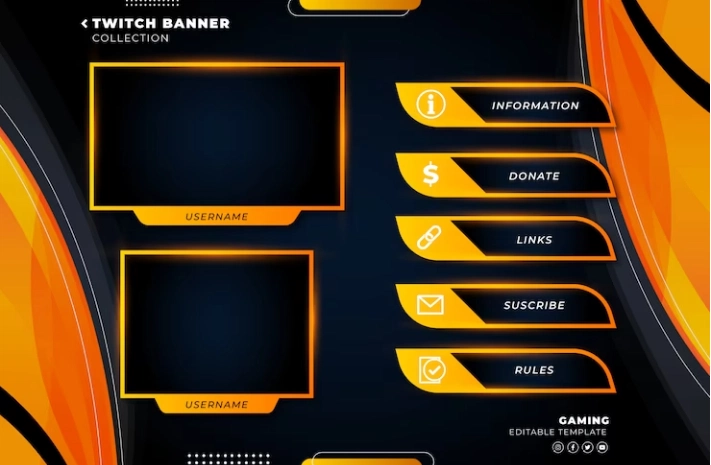Native advertising emerged as a product of evolution in the world of digital marketing. Its ability to integrate harmoniously with a platform’s content makes it an attractive option for advertisers and consumers alike. Today we want to explain what native advertising is, its advantages and some examples so that you understand it in depth. Keep reading to learn.

Do you want to start monetizing in streaming now?
Reach Gen Z through major streaming platforms!
What is native advertising?

Native advertising is a form of digital advertising that can be integrated almost perfectly into the environment in which it is located. Unlike traditional advertisements that are intrusive and clearly separated from the content, this is camouflaged in the context in which it appears, so that it blends into the user experience. This is achieved through various formats, such as sponsored articles, promoted videos, social media posts, among others.
One of the key aspects of native advertising is that it doesn’t look like advertising at first glance. Which results in a less intrusive and more enjoyable experience for people, and helps increase ad effectiveness.
Advantages
Native advertising offers a number of benefits to advertisers, consumers, and content publishers alike, including:
- Because native advertising is mixed with content, users are more likely to interact with it, resulting in higher click-through rates and greater retention of advertising information. This high rate could also be achieved with advertising campaigns or SEM campaigns , but they do not mix the tone with the content.
- Being integrated into the content, it tends to be more relevant to the target audience, the ads are shown to the right people at the right time, thus increasing. Native ads do not aggressively disrupt the user experience, which prevents consumer resistance to advertising and the possibility of using ad blockers.
- Since it does not look like traditional advertisements, it usually generates more confidence in consumers, since it is not perceived as an aggressive sales advertising strategy .
- Native ads contribute to a smoother and more enjoyable user experience, this is especially beneficial for content publishers who want to keep their audience satisfied
If you are very interested in advertising, I invite you to read the article: programmatic advertising
Disadvantages
Despite the many advantages of native advertising, there are also some disadvantages that must be understood in detail and kept in mind when creating them:
- Measuring the effectiveness of native advertising can be challenging as it does not lend itself to traditional click or impression metrics, thus making it difficult to accurately quantify return on investment.
- If native advertising is not clearly labeled or marked as advertising, consumers may confuse it with genuine editorial content, raising ethical concerns and eroding public trust.
- Creating high-quality native content is sometimes expensive, often requiring considerable time and resources to develop truly effective native ads.
- As native advertising becomes more popular, there is a risk of saturation on certain channels or platforms. If this happens, its effectiveness will decrease as users become more immune to the strategy.
- Not all platforms are suitable for native advertising. Some formats may not be effective on certain websites or applications, limiting their reach.
Types of native advertising

This type of advertising takes forms and formats, it is modified to fit the specific needs of advertisers and the platform on which it is presented. Some of the most common types of native advertising include:
Sponsored articles
These are articles written in the tone and style of the content of the website on which they are published, but are created by or for a brand with promotional intentions.
Social media ads
Social media platforms offer opportunities to publish promoted content that is mixed with the user’s organic content, such as sponsored posts on Facebook or Instagram, stories or reels.
Multimedia content
Native ads can also include videos, infographics, or even podcasts that don’t break the content flow of the platform on which they are displayed.
Sponsored Listings
These commonly appear on e-commerce sites and search engines, where a company’s products or services are highlighted among organic results.
In-feed advertising
It’s found in the content feed, whether it’s on a news website, social media app, or content recommendation platform. These ads are presented in a format similar to the user’s regular posts.
Related Content Widgets
At the end of an article or web page, it is common to find widgets that display related content. Some of these links may be advertisements disguised as related content.
Successful examples of brands that have used native advertising

Native advertising has proven to be an effective advertising strategy for brands , it works for a wide range of brands in various sectors. Here are some examples of brands that have successfully leveraged native advertising:
BuzzFeed vs Tasty
BuzzFeed is known for its viral content, and its cooking section, Tasty, has used native advertising in creative ways. They have created recipes and video tutorials sponsored by food brands, which blends perfectly with their regular content and engages their audience.
Netflix
Netflix has used native advertising on platforms such as Instagram and Twitter to promote its original series and movies. They use images and descriptions that resemble regular users’ posts, such as memes or humorous videos with jokes created by the same audience on their personal accounts.
Airbnb
The accommodation rental platform uses native advertising on platforms such as Facebook and Google. Their ads are coherently integrated with users’ search results or content, showing them, for example, getaways and activities related to searches that users have done.
Red Bull
Red Bull has used native advertising to promote extreme sports and events. Through sponsored articles and videos that relate to their brand, they have managed to connect with their target audience in an authentic way, appealing to virality.
The New York Times
Even leading publishers like The New York Times have embraced native advertising. They have produced sponsored content that fits the tone and style of their regular articles, giving brands the opportunity to reach a diverse and engaged audience, partnering with their loyal readers.
Challenges you may face and considerations before starting
If you’re considering using native advertising in your guerrilla marketing strategy , it’s important to keep a few key challenges and considerations in mind:
Clear label
It is very important that any native advertising content is transparently labeled as advertising. Don’t mislead consumers into believing they are viewing genuine editorial content.
Content quality
The quality of the content matters a lot. Native advertising must be relevant, valuable and attractive to the audience. Investing in creating high-quality content is essential.
Target audience
Clearly identify your target audience, this is a pillar in any type of advertising. If you don’t know who you want to target or how to communicate with the audience you want to reach, the quality of the ads will not matter, they will not be as effective as you expect.
Integration with the general strategy
Native advertising should fit cohesively with your overall marketing strategy. Make sure it’s part of a comprehensive approach.
Continuous evolution
Native advertising is constantly evolving. Stay on top of trends and adjust your strategy as audience preferences and platforms change.
Advertise your brand without intrusive ads in Streaming
Traditional ads are annoying. They are interruptions to the viewing experience that can cause viewers to skip ads or even leave the platform.
At Streamion you can monetize your live broadcasts without annoying interruptions, offering a seamless experience to your audience. We offer a non-intrusive advertising solution for streaming channels. Our ads integrate naturally into the content. In addition, our service is super reliable, there are many types of advertising agencies that have trusted us.
With Streamion, you can reach your audience with ads that:
- They adapt to the content that viewers are watching, to ensure its relevance.
- They do not interrupt the viewing experience, ensuring a better experience for the viewer.
If you want to know more, visit our website.

Want to start advertising on stream?
This is your chance to reach Generation Z through the leading streaming platforms!
Conclusion
It is vitally important to find more effective ways to reach users. With the bombardment of information that the average person receives every day, integrating advertising in the least invasive way possible is essential. This way of advertising value propositions offers advantages such as greater engagement and relevance, two things that should never be underestimated. We can conclude by saying that, as a company, seeking to provide the best user experience to the target audience must be a priority objective. Within this, native advertising is clearly one of the best ways to achieve this.






